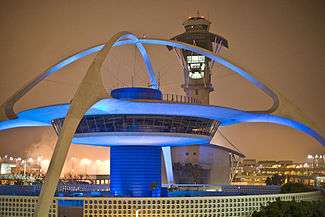Charles Luckman
| Charles Luckman | |
|---|---|
| Born |
May 16, 1909 Kansas City, Missouri, US |
| Died |
January 26, 1999 (aged 89) Los Angeles, California, US |
| Nationality | American |
| Spouse(s) | Harriet Luckman |
| Children |
Charles Luckman, Jr. James Luckman Stephen Luckman |



Charles Luckman (May 16, 1909 in Kansas City – January 26, 1999 in Los Angeles) was an American businessman and architect, famous as the "Boy Wonder of American Business" when he was named president of the Pepsodent toothpaste company in 1939 at the age of 30. Through acquisition, he later became president of Lever Brothers.
Biography
Born to an American family,[1] Luckman had always wanted to be an architect. As a nine-year-old paper boy outside the Muehlebach Hotel in Kansas City, he asked a customer about the pretty lights and was told they were called "chandeliers." Then he asked, "Who does... Who decides on things like that?" "An architect," came the reply. "He designs the hotel and says to put the chandeliers there." Luckman wrote in his memoir, "Right then and there I decided to become an architect." He trained at the University of Illinois where he was a member of the Professional Engineering Fraternity Theta Tau, and the Social Fraternity Chi Psi but went into sales after graduating during the depths of the Great Depression. After nearly 20 years of great success in business, he helped plan Lever Brothers' New York skyscraper, Lever House, one of the first sealed glass towers that began the curtain wall trend. The complex, designed by Gordon Bunshaft of Skidmore, Owings & Merrill, was innovative in several other ways, as well, including a rare public plaza at ground level.
Reminded of his architectural roots, Luckman resigned the presidency of Lever Brothers, moved to Los Angeles and began practicing architecture with fellow University of Illinois graduate William Pereira c. 1950 as Pereira & Luckman. Their partnership led to works such as CBS Television City and the master plans for Edwards Air Force Base and Los Angeles International Airport.[2] Luckman and Pereira went separate ways in 1959. Luckman's firm went on to design the Prudential Tower in Boston, The Forum in Inglewood, the new Madison Square Garden in New York City, Aloha Stadium in Honolulu, Aon Center in Los Angeles, and the NASA Manned Spacecraft Center in Houston.
Public service
In 1946, President Harry Truman appointed Luckman to serve on the President's Committee on Civil Rights. Then in 1947, President Truman asked him to help feed starving Europe. For this work, he was honored with Britain's Order of St. John, France's Legion of Honor, and Italy's Star of Solidarity.
Personal life
He was married to Harriet Luckman; they had three sons: Charles, Jr., James, and Stephen.[3]
Portfolio
- Robertson Gymnasium, Santa Barbara, 1959
- Msgr. Farrell High School, Staten Island, New York, 1961
- Theme Building, Los Angeles International Airport, Los Angeles, California, 1961
- Lyndon B. Johnson Space Center (formerly the Manned Spacecraft Center), Houston, 1962–1963
- 9200 Sunset (formerly the Luckman Plaza), West Hollywood, 1964
- Prudential Tower, Boston, 1960–1964
- Kennedy Space Center (formerly the Launch Operations Center and Launch Operations Directorate), Merrit Island, 1964–1965
- Federal Pavilion (demolished in 1977), New York City, 1964
- The Forum, Inglewood, 1967
- The Chesterfield Building, Cleveland, Ohio, 1967
- Madison Square Garden, New York City, 1968
- Chicago Marriott Downtown Magnificent Mile, Chicago, 1969
- 20 Hawley Street (formerly One Marine Midland Plaza), Binghamton, New York, 1969
- McDonald Investment Center (also known as the Key Center, formerly the Central National Bank Building), Cleveland, 1969
- Wells Fargo Plaza (formerly the First National Bank Plaza and First Interstate Bank Building), Phoenix, 1971
- Wells Fargo Plaza (formerly the Norwest Plaza and State National Bank Building), El Paso, 1971
- Wells Fargo Center (formerly the First Interstate Tower and First National Bank Tower), Portland, Oregon, 1969–1972
- Los Angeles Convention Center (partially demolished), Los Angeles, 1972
- Macy's Plaza (formerly The Broadway Plaza), Los Angeles, 1973
- Aon Center (also known as 707 Wilshire, formerly the First Interstate Tower and United California Bank Building), Los Angeles, 1972–1973
- Frost Bank Tower, San Antonio, 1975
- Aloha Stadium, Hawaii, 1975
- Hyatt Regency Dearborn, 1976
- Hyatt Regency Phoenix, 1976
- Disney Epcot Center, Florida 1982
References
- ↑ Vanity Fair: "Forever Modern" October 2002
- ↑ Will Wiles, Jet-Age Modernism, iconeye, 1 April 2014.
- ↑ New York Times: "Charles Luckman, Architect Who Designed Penn Station's Replacement, Dies at 89" by HERBERT MUSCHAMP January 28, 1999
External links
- Charles Luckman Papers, 1908-2000, Loyola Marymount University, Department of Archives and Special Collections, William H. Hannon Library (see linked pdf for details and biography)
- Charles Luckman at the archINFORM database.
- Time Magazine, June 10, 1946
